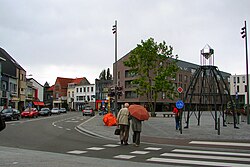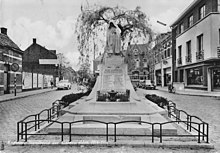Kapellen, Belgium
Kapellen | |
|---|---|
 Town centre | |
| Coordinates: 51°19′N 04°26′E / 51.317°N 4.433°E | |
| Country | |
| Community | Flemish Community |
| Region | Flemish Region |
| Province | Antwerp |
| Arrondissement | Antwerp |
| Government | |
| • Mayor | Dirk Van Mechelen (open VLD) |
| • Governing party/ies | open VLD, N-VA |
| Area | |
• Total | 37.22 km2 (14.37 sq mi) |
| Population (2020-01-01)[1] | |
• Total | 26,981 |
| • Density | 720/km2 (1,900/sq mi) |
| Postal codes | 2950 |
| NIS code | 11023 |
| Area codes | 03 |
| Website | www.kapellen.be |
Kapellen (Dutch pronunciation: [kɑˈpɛlə(n)], old spelling: Cappellen) is a municipality located in the Belgian province of Antwerp. The municipality lies in the Campine in the northern part of the province.
Kapellen consists only of the town of Kapellen proper. On January 1, 2018, Kapellen had a total population of 26,771. The total area is 37.11 km² which gives a population density of 720 inhabitants per km². Kapellen consists out of multiple neighborhoods, Kapellen Center, the eastern part of Putte, Kapellenbos, Hoogboom and Zilverenhoek. A number of neighbourhoods in Kapellen have a residential character and are characterized by their villaparcs, exclusive landhouses, and beautiful castles. Many who flee the always busy town enjoy Kapellen's peaceful nature.
The town's football club is R. Cappellen F.C. and has played at the national level for many years.
History
The communities that are now part of Kapellen date back to the 13th century. Hoogboom can be found as Hobonia on documents from 1267. Hoghescote, the current center can be seen 10 years after Hoogboom in Ertbrand, which has now become Putte. De neighborhood Zilverenhoek, only a part of Kapellen since 1983, has its first appearance in 1844 on a cadastral plan.
Since its origin Kapellen has been a part of lordship Ekeren. Since the 13th century, parts of the territory have regularly changed ownership. Eventually, in 1714 the entire lordship Ekeren came under the ownership of one family, one of the lords Salm-Salm. During the French occupation, Kapellen became, in 1795, part of the municipality Stabroek until it, eventually, in 1800, became its own municipality. Since then they have slowly been adding neighborhoods of Ekeren, Hoevenen and Stabroek to the territory of Kapellen. The current municipal borders have been determined since 1983 when the neighborhoods Hoogboom and Zilverenhoek from Ekeren became part of Kapellen.[2]
In comparison to its worldly power, its spiritual power has had a less complex history. The parish of Hoghescote became part of the St. Bernard's Abbey of Hemiksem. Until then the parish depended on the Saint-Lambertus church of Ekeren.
The church of Kapellen is the oldest building in the municipality. Until the 14th century a chapel sufficed to help the people who lived there. The church has been built up and renovated further throughout the ages. The chancel for example dates back to the 14th century while the Transept was built in the 16th century. During the 19th century, the tower and the interior of the church were renovated in with a neogothic look.

The further history of Kapellen is characterized by periods of growth and poverty. During the Fall of Antwerp Kapellen suffered greatly. All important buildings and 90% of all houses were destroyed. During the Twelve Years' Truce there was a short resurgence of the municipality until 1623, when the plague raged. The real resurgence had to wait until 1674 when the church was rebuilt.
All this abruptly ended with the start of World War I. The forced service for the German army and the Spanish flu caused many deaths. After the war, there was a brief recovery period until 1930, when a crisis fell over the municipality. Recovery had to wait until after World War II. The municipality Kapellen was freed on October 4, 1944 by the Canadian battalion Les Fusiliers Mont-Royal.[3][4]
Famous inhabitants
- Christine Soetewey, retired Belgian high jumper
- Sam Bettens and Gert Bettens, musicians, K's Choice
- Geert Grub (1896–1980), poet, writer and Flemish activist
- Margaretha Guidone, activist for the environment and against global warming
- Didier Ilunga Mbenga, NBA basketball player
- Baron Paul Kronacker (1897–1994), politician
- Tom De Mul, football player currently playing for Sevilla FC
- Kevin Van Dessel, football player currently playing for Roda JC
- Dirk Van Mechelen, politician, Flemish minister
- Thomas Vermaelen, football player currently playing for FC Barcelona
- Gordan Vidovic, former football player
- Rocco Granata, singer
References
- ^ "Bevolking per gemeente op 1 januari 2020". Statbel.
- ^ Bruno Verbergt, Ik ben van Ekeren. Ekeren-Hoogboom. Hoe een deel van Ekeren niet met Antwerpen fuseerde in 1983 (CC Ekeren, 23 mei 2013)
- ^ "Les Fusiliers Mont-Royal", Wikipedia, 2020-01-07, retrieved 2020-01-08
- ^ "Kapellen herdenkt bevrijding". Nieuwsblad.
{{cite news}}: CS1 maint: url-status (link)
External links
 Media related to Kapellen, Belgium at Wikimedia Commons
Media related to Kapellen, Belgium at Wikimedia Commons- (in Dutch) Official website





